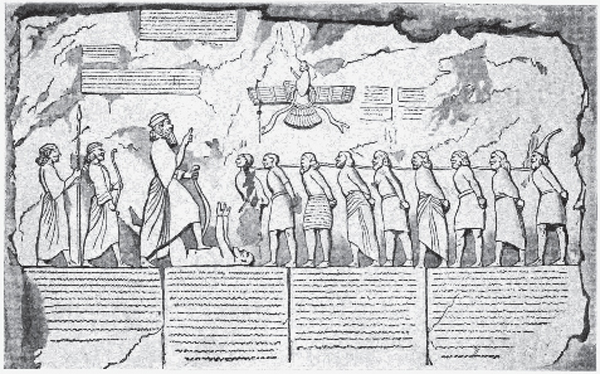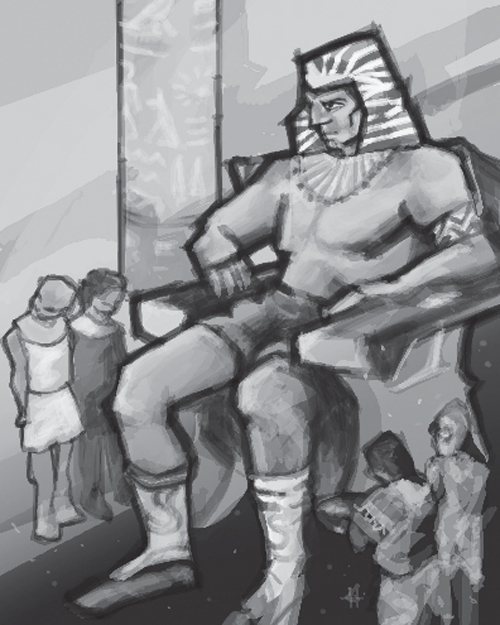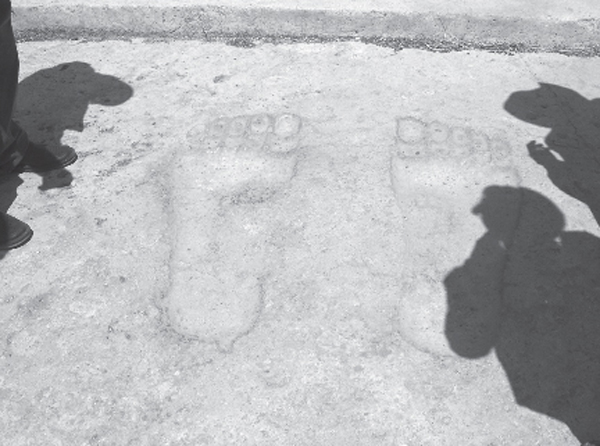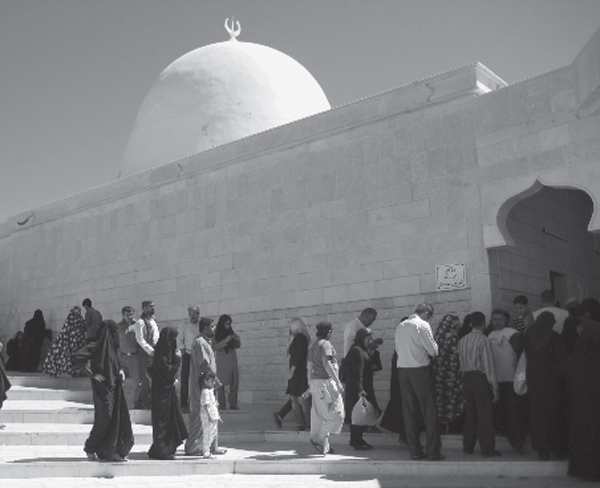CHAPTER 7
ANCIENT GIANTS OF EGYPT, SYRIA, IRAQ, AND IRAN
History is a wheel, for the nature of man is fundamentally unchanging. What has happened before will perforce happen again.
GEORGE R. R. MARTIN
DARIUS THE GREAT AND IRAN’S ANCIENT PERSIAN EMPIRE
Darius the Great ruled the Persian Empire at its zenith, leaving behind a legacy of goodwill and total militaristic domination. The Behistun Inscription, a multilingual engraving written on a mountain high in western Iran, was crucial to the decipherment of cuneiform script. It also depicts Darius as a giant standing tall over his minuscule captives. With a proclaimed lineage to the semi-divine rulers of Persia’s bejeweled past, it makes sense that Darius was indeed a giant. When Alexander the Great conquered Persepolis in 330 BCE and sat upon the throne of Darius, his feet dangled in the air far from the quartz floor beneath him. The tomb of Darius is a popular tourist attraction when visiting the ancient site of Persepolis, yet nobody knows for sure that it ever really held or holds the giant skeleton of Darius the Great. It would be interesting to excavate whatever is inside the tomb, and if it’s a giant skeleton it might be worth the desecration.

Fig. 7.1. The Behistun Inscription (L’Homme et la terre, tome 1, 1905)
IRAQ AND THE LEGEND OF GILGAMESH
In the nearby city of Kalar, in Iraq, the bones of men more than ten feet tall were discovered by archaeologists in the hills of Rahim in Rizgari city. Mohamed Ali, the official media mouthpiece of the Department of Archaeology, explained, “We found a number of graves here. The skeleton of the men are so big and tall that they are abnormal. These remains could date back thousands of years BC. We are now working on cleaning the graves. There are four of them. The height of men according to their skeletons is about 3 meters (about 10 feet) they are fascinating.”1 No other information has emerged about this discovery due to the secluded culture of Iran and the ongoing general destruction of Iraq.
The legendary giant Gilgamesh was the first hero of the ancient world. He was the historical ruler and builder of the city of Uruk nearly five thousand years ago. The poem that describes his tales, The Epic of Gilgamesh, is the oldest known piece of epic poetry ever written. It even has a flood myth almost identical to the one found in the Bible thousands of years later. Like Hercules, Gilgamesh was such a mythical figure that the idea of locating his tomb seemed unrealistic and a fantasy until 2003 when a group of German archaeologists shocked the world by announcing they had discovered his ancient lost tomb near a driedup area of the Euphrates River in northern Iraq. Unfortunately, and not surprisingly, the Iraq war broke out shortly after and any updates of the discovery were never announced again. From the original BBC article in 2003:
The Epic Of Gilgamesh—written by a Middle Eastern scholar 2,500 years before the birth of Christ—commemorated the life of the ruler of the city of Uruk, from which Iraq gets its name. Now, a German-led expedition has discovered what is thought to be the entire city of Uruk—including, where the Euphrates once flowed, the last resting place of its famous King. “I don’t want to say definitely it was the grave of King Gilgamesh, but it looks very similar to that described in the epic,” Jorg Fassbinder, of the Bavarian department of Historical Monuments in Munich, told the BBC World Service’s Science in Action programme. In the book—actually a set of inscribed clay tablets—Gilgamesh was described as having been buried under the Euphrates, in a tomb apparently constructed when the waters of the ancient river parted following his death. “We found just outside the city an area in the middle of the former Euphrates River. The remains of such a building which could be interpreted as a burial,” Mr. Fassbinder said. He said the amazing discovery of the ancient city under the Iraqi desert had been made possible by modern technology. “By differences in magnetisation in the soil, you can look into the ground,” Mr Fassbinder added. “The difference between mudbricks and sediments in the Euphrates River gives a very detailed structure.” This creates a magnetogram, which is then digitally mapped, effectively giving a town plan of Uruk. “The most surprising thing was that we found structures already described by Gilgamesh,” Mr Fassbinder stated. “We covered more than 100 hectares. We have found garden structures and field structures as described in the epic, and we found Babylonian houses.” But he said the most astonishing find was an incredibly sophisticated system of canals. “Very clearly, we can see in the canals some structures showing that flooding destroyed some houses, which means it was a highly developed system. [It was] like Venice in the desert.”2
Gilgamesh was an interesting figure, and the discovery of his body would be a huge deal. The Book of Giants, recovered from the Dead Sea scrolls,*1 mentions the king Gilgamesh as one of the mighty antediluvian Nephilim giants who ruled before the flood. He was said to have been half-god, and somewhere between sixteen to eighteen feet tall! If this was confirmed it would turn the established timeline of history upside down and cause earthquakes throughout the halls of the academic world. No wonder they weren’t in a hurry to dig him up.
EGYPT’S GIANT PHARAOHS AND MUMMIES
The ancient lands of Egypt are flush with mysterious monuments and tales of giants. You can even see them in the hieroglyphs upon the murals of wall paintings that dominate ancient temples. The depictions of some of the pharaohs clearly show a staggering height difference that cannot be explained away as simply artistic license. In 2001 a skeleton known as the Giza Mulhern giant was dug up from a Fifth Dynasty mastaba tomb in cemetery 2500 in western Giza by archaeologists from Howard University. Despite the skeleton only measuring around six and a half feet, the skull and the jawbone were abnormally large, so much so that mainstream academia declared the Mulhern giant the first case of gigantism in ancient Egypt.3 Yet, despite this first, the skull has been hidden away by academia and the remaining bones promptly lost.

Fig. 7.2. Giant pharaoh, Bethoven M. Tiano (2016)
Swiss nightclub mogul Gregory Spörri spent 1988 roaming around Egypt in search of mysteries in both inner and outer spaces and what he found ended up changing his life forever. About an hour’s drive northeast of Cairo, Spörri met a family of ancient grave robbers in a farmhouse in Bir Hooker, where he was shown a mummified giant’s finger that was wrapped in old rags and leather skin. An astonished Spörri told the prominent German newspaper BILD.de, “It was an oblong package, smelled musty. I was absolutely flabbergasted when I saw the dark brown relic.”4 Spörri was allowed to handle the giant finger and also photograph it next to an Egyptian monetary note to get a size comparison. He tried to buy the relic but the family refused to sell it, and Spörri returned to Switzerland armed only with a few photographs of the finger and a mind-blowing personal experience. The few scientists that he showed the photographs to all mocked him and didn’t take him seriously, so Spörri put the photos away and continued to live his clubowning playboy lifestyle. But the thought of ancient giants once existing in Egypt kept nagging him. Twenty years after his first encounter with the giant finger, he returned to Egypt in hopes of rediscovering the mysterious relic of Bir Hooker. But the family of grave robbers and the finger had vanished.
GIANT FOOTPRINTS AND GRAVES IN SYRIA
At the ancient temple of Ain Dara in Syria, several huge three-foot-long footprints are clearly visible in the courtyard leading into the sanctuary of the temple (see fig. 7.3). The giant who made these impressions must have been fifteen to twenty feet tall!
In 2005, a group of Russian scientists led by Professor Ernst Muldashev announced they had discovered a grave of giants near the site of the giant’s footprints at Ain Dara and also discovered more giant burial sites throughout Syria but were unable to excavate them due to various reasons, ranging from political to ideological. In a Q & A interview with Pravda Professor Ernst Muldashev explained:

Fig. 7.3. Giant footprints of Ain Dara (Institute for the Study of the Ancient World Contact, 2016)
Q: Many a legend and fairy tale mention giants and titans. Why do you think no giant bones have been found so far?
A: Ancient giants may have never buried their dead in the ground the way we do. Different people in the present-day world bury the dead differently. It is a custom in India to burn the dead and throw the ashes in water. It seems to me that ancient people put the dead bodies into sarcophaguses where the bodies dematerialized and turned into a kind of energy blobs that were used by living people for various purposes. That is why the bones of giant people may never be found.
Q: Did you find any?
A: No, we did not. But we found the graves of ancient giants.
Q: Could you please elaborate.
A: The grave of Abel, the second son of Adam and Eve, is the most famous and significant grave. It is located in the vicinity of Damascus. . . . The tombstone of Abel’s grave is a granite structure about six meters [nineteen and a half feet] long and 1.80 meters wide. There are orifices on the side of the gravestone. You can smell a strange odor if you get closer to the orifices.
Q: Has anybody ever tried to open the grave and study the contents?
A: Muslims will never allow anybody to open the grave. It would be regarded as desecration of a grave.
Q: You mentioned a few graves of the giants found by your expedition, did you not?
A: Yes, I did. The long search finally resulted in the discovery of several gigantic graves located near the city of Aleppo in Syria. The graves used to be a sacred place for worshippers. However, some locals told us that radical Muslims destroyed the cemetery a few years ago.

Fig. 7.4. Giant tomb of Abel located at the Nabi Habeel Mosque in Syria (photo by Toushiro, 2004)

Fig. 7.5. Entrance to the Nabi Habeel Mosque to see the giant tomb of Abel (photo by Toushiro, 2004)
They bulldozed the tombstones. We could have started an excavation on the site but we never did. We did not know how the locals would react to our digging in their ground. The locals showed us another grave of a giant. It sits on top of the hill some 20 kilometers away from the destroyed cemetery. The locals call the place a “grave of a 7.5-meter man.” The giant was called “Muhammad Attaul” or Muhammad the Tall One. Legend has it that the giant came down from Yemen. He was a miracle man, he could speak a form of Arabic used by the prophet Muhammad. He was killed and buried there. The treasure diggers vandalized the grave two years ago. They were caught and thrown into jail. Local peasants are now trying to restore the grave. They already placed a few boulders around it and built a stone fence.
Q: Do you really believe that giant people were buried in those graves?
A: Nobody can tell for sure until the graves are opened and bones are found. But the Syrian authorities are unlikely to authorize the opening of the graves.5
The Ras Shamra Tablets, discovered in 1928 in a mound near the ancient city of Ugarit, located on the Syrian coast, provide more information about ancient giants and frequently mention the Rephaim of Hebrew legend. The tablets even describe the Mesopotamian hero Gilgamesh as being sixteen and a half feet tall. The linguists who deciphered the cuneiform texts concluded they were written around the time of Joshua. According to pioneering Egyptologist Henry Hall, Ph.D., the Rephaim (giants) were the ones responsible for building all the megalithic monuments, dolmens, and the menhirs of Moab in eastern Syria. Considering that Syria has been and is currently being torn to shreds by imperialistic globalist forces, it’s doubtful that any progress of digging up the bones of ancient giants will be happening there. Also there’s little chance of excavating any time soon in either Iraq or Iran. Egypt is still moderately accessible, but the general uncertainty of the Middle East and the fear of radical Islamic terrorists have put a halt to most archaeological excavations.